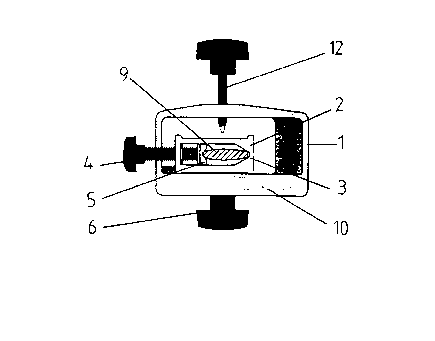Une partie des informations de ce site Web a été fournie par des sources externes. Le gouvernement du Canada n'assume aucune responsabilité concernant la précision, l'actualité ou la fiabilité des informations fournies par les sources externes. Les utilisateurs qui désirent employer cette information devraient consulter directement la source des informations. Le contenu fourni par les sources externes n'est pas assujetti aux exigences sur les langues officielles, la protection des renseignements personnels et l'accessibilité.
L'apparition de différences dans le texte et l'image des Revendications et de l'Abrégé dépend du moment auquel le document est publié. Les textes des Revendications et de l'Abrégé sont affichés :
| (12) Demande de brevet: | (11) CA 2271171 |
|---|---|
| (54) Titre français: | SUPPORT POUR AIGUISAGE D'OUTILS TRANCHANTS |
| (54) Titre anglais: | JIG FOR GRINDING SHARP-EDGED TOOLS |
| Statut: | Réputée abandonnée et au-delà du délai pour le rétablissement - en attente de la réponse à l’avis de communication rejetée |
| (51) Classification internationale des brevets (CIB): |
|
|---|---|
| (72) Inventeurs : |
|
| (73) Titulaires : |
|
| (71) Demandeurs : |
|
| (74) Agent: | NORTON ROSE FULBRIGHT CANADA LLP/S.E.N.C.R.L., S.R.L. |
| (74) Co-agent: | |
| (45) Délivré: | |
| (22) Date de dépôt: | 1999-05-06 |
| (41) Mise à la disponibilité du public: | 1999-11-13 |
| Licence disponible: | S.O. |
| Cédé au domaine public: | S.O. |
| (25) Langue des documents déposés: | Anglais |
| Traité de coopération en matière de brevets (PCT): | Non |
|---|
| (30) Données de priorité de la demande: | ||||||
|---|---|---|---|---|---|---|
|
Jig for grinding sharp-edged tools. The jig consists of a housing (1) in the
form of a
casing designed with a passage running through it whose at least one end (10)
is flat, plus a seat
(2), also in the form of a casing designed with a passage running through it,
located in the
passage of the housing and lockable (6) in this housing in an inclined
position in relation to the
passage in the housing, whereby the seat (2) is provided with a clamping
device (4) for firmly
holding a tool that is to be ground so that it extends through the passage of
the seat, and that the
seat (2) has such a length that one end of it extends out beyond the housing
at the flat end (10) of
the housing.
Note : Les revendications sont présentées dans la langue officielle dans laquelle elles ont été soumises.
Note : Les descriptions sont présentées dans la langue officielle dans laquelle elles ont été soumises.

2024-08-01 : Dans le cadre de la transition vers les Brevets de nouvelle génération (BNG), la base de données sur les brevets canadiens (BDBC) contient désormais un Historique d'événement plus détaillé, qui reproduit le Journal des événements de notre nouvelle solution interne.
Veuillez noter que les événements débutant par « Inactive : » se réfèrent à des événements qui ne sont plus utilisés dans notre nouvelle solution interne.
Pour une meilleure compréhension de l'état de la demande ou brevet qui figure sur cette page, la rubrique Mise en garde , et les descriptions de Brevet , Historique d'événement , Taxes périodiques et Historique des paiements devraient être consultées.
| Description | Date |
|---|---|
| Inactive : CIB expirée | 2012-01-01 |
| Inactive : CIB de MCD | 2006-03-12 |
| Inactive : CIB de MCD | 2006-03-12 |
| Le délai pour l'annulation est expiré | 2005-05-06 |
| Demande non rétablie avant l'échéance | 2005-05-06 |
| Réputée abandonnée - omission de répondre à un avis sur les taxes pour le maintien en état | 2004-05-06 |
| Inactive : Abandon.-RE+surtaxe impayées-Corr envoyée | 2004-05-06 |
| Inactive : Page couverture publiée | 1999-11-19 |
| Demande publiée (accessible au public) | 1999-11-13 |
| Lettre envoyée | 1999-08-10 |
| Inactive : Transfert individuel | 1999-07-12 |
| Modification reçue - modification volontaire | 1999-07-12 |
| Inactive : CIB attribuée | 1999-06-25 |
| Inactive : CIB en 1re position | 1999-06-25 |
| Inactive : Lettre de courtoisie - Preuve | 1999-06-15 |
| Inactive : Certificat de dépôt - Sans RE (Anglais) | 1999-06-10 |
| Exigences de dépôt - jugé conforme | 1999-06-10 |
| Demande reçue - nationale ordinaire | 1999-06-07 |
| Date d'abandonnement | Raison | Date de rétablissement |
|---|---|---|
| 2004-05-06 |
Le dernier paiement a été reçu le 2003-04-14
Avis : Si le paiement en totalité n'a pas été reçu au plus tard à la date indiquée, une taxe supplémentaire peut être imposée, soit une des taxes suivantes :
Les taxes sur les brevets sont ajustées au 1er janvier de chaque année. Les montants ci-dessus sont les montants actuels s'ils sont reçus au plus tard le 31 décembre de l'année en cours.
Veuillez vous référer à la page web des
taxes sur les brevets
de l'OPIC pour voir tous les montants actuels des taxes.
| Type de taxes | Anniversaire | Échéance | Date payée |
|---|---|---|---|
| Taxe pour le dépôt - générale | 1999-05-06 | ||
| Enregistrement d'un document | 1999-07-12 | ||
| TM (demande, 2e anniv.) - générale | 02 | 2001-05-07 | 2001-05-04 |
| TM (demande, 3e anniv.) - générale | 03 | 2002-05-06 | 2002-04-09 |
| TM (demande, 4e anniv.) - générale | 04 | 2003-05-06 | 2003-04-14 |
Les titulaires actuels et antérieures au dossier sont affichés en ordre alphabétique.
| Titulaires actuels au dossier |
|---|
| TORMEK AB |
| Titulaires antérieures au dossier |
|---|
| TORGNY JANSSON |